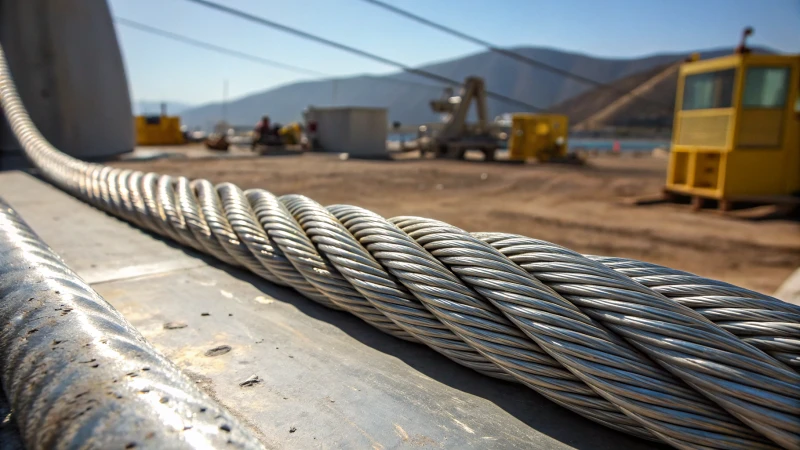
Remember that time when a single overlooked detail derailed a project? Let’s make sure that doesn’t happen with your steel wire ropes.
To ensure the durability and performance of steel wire rope products, choose the right material and construction for your needs, use advanced coatings to fight corrosion, and implement a regular maintenance routine.
I once faced a situation where the ropes we used weren’t quite up to the task. It taught me the importance of diving deeper into material choices and construction options. From opting for high-carbon or stainless steel to exploring innovative coatings like zinc-aluminum alloys, each decision can vastly improve durability. And don’t forget about pre-stretching techniques—these can significantly boost load distribution and reduce deformation risks. Remember, it’s not just about having a rope; it’s about having the right rope for your specific challenge.
Advanced coatings enhance steel wire rope durability.True
Coatings protect against corrosion, extending the lifespan of ropes.
Regular maintenance is unnecessary for steel wire ropes.False
Maintenance prevents wear and damage, ensuring optimal performance.
What Are the Best Materials for Durable Steel Wire Ropes?
Ever stood amidst towering construction cranes or deep within a mine and wondered what keeps everything together? The secret lies in choosing the right material for steel wire ropes.
The best materials for durable steel wire ropes are high-carbon steel, offering great strength and flexibility, and stainless steel, known for its excellent corrosion resistance. Enhancing these with innovative zinc-aluminum coatings further boosts their longevity and resilience.
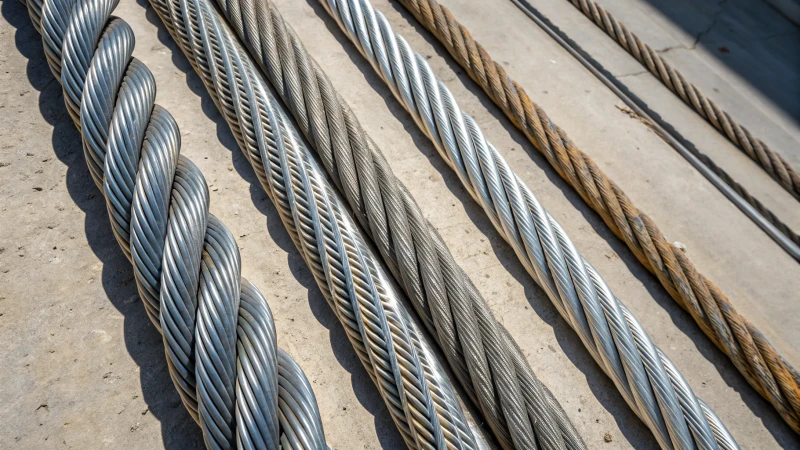
High-Carbon Steel: A Robust Choice
High-carbon steel quickly stood out as a robust choice due to its unmatched strength and flexibility, making it perfect for those tough environments where ropes have to carry significant loads. It’s like having a trusty old friend who you know won’t let you down, even when the going gets tough. However, like any good friendship, it requires care—regular maintenance is a must to prevent corrosion.
| Advantages | Disadvantages |
|---|---|
| High Strength | Susceptible to corrosion without coating |
| Good Flexibility | Requires regular maintenance |
Stainless Steel: Corrosion Resistance at Its Best
Stainless steel was my go-to when dealing with projects near the sea, where the salty air can be unforgiving. Its resistance to rust and corrosion is like a shield, thanks to the protective layer of chromium. Yes, it might pinch the budget a bit more than other materials, but I’ve found its durability1 in corrosive settings justifies every penny spent.
Innovative Coatings: Enhancing Longevity
In recent years, I’ve been amazed by advancements in coating technologies. Zinc-aluminum alloy coatings have transformed how long steel wire ropes last, boosting corrosion resistance by up to 40%. This innovation feels like a game-changer, especially when working in coastal or industrial areas where durability is non-negotiable.
| Coating Type | Benefits |
|---|---|
| Zinc-Aluminum | Superior corrosion resistance |
| PVC Coating | Enhanced flexibility and grip |
Pre-Stretching Techniques: Improving Load Distribution
I learned about pre-stretching during a project where load distribution was crucial. This manufacturing technique ensures that the load is spread evenly across the rope, reducing the risk of deformation under heavy weights. It’s like prepping for a big event—ensuring everything is ready to perform under pressure. For heavy-duty tasks2, pre-stretched ropes are my recommendation for peace of mind and extended service life.
High-carbon steel is ideal for marine environments.False
High-carbon steel lacks corrosion resistance needed for marine settings.
Zinc-aluminum coatings improve corrosion resistance by 40%.True
Zinc-aluminum coatings offer up to 40% better corrosion resistance.
How Do Coating Technologies Boost Steel Wire Rope Performance?
When I first stumbled upon the world of steel wire ropes, I was amazed by how something so industrial could be so fascinating.
Coating technologies improve steel wire rope performance by significantly enhancing corrosion resistance, durability, and flexibility. With advancements like zinc-aluminum alloy coatings, the lifespan of these ropes can increase by up to 40%, making them particularly suitable for challenging environments.
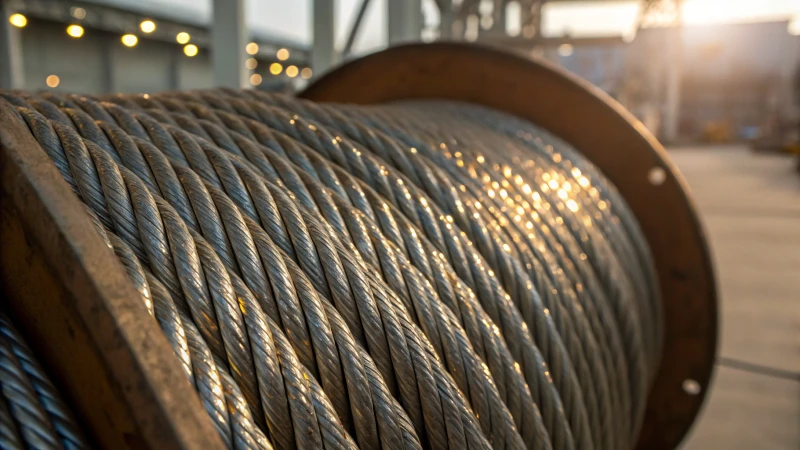
The Role of Coatings in Corrosion Resistance
I remember the first time I saw a steel wire rope exposed to the elements. It was part of an old crane left to rust in a yard, each strand corroded to the point where it seemed to crumble at a touch. That image stuck with me as a reminder of how relentless the environment can be. Traditional galvanizing methods offer some protection, but in extreme conditions, they often fall short.
Innovative coating technologies, like zinc-aluminum alloys, have been game-changers. These coatings form a robust shield that keeps moisture and chemicals at bay, effectively boosting corrosion resistance by up to 40% over older methods. This advancement is like giving those ropes a suit of armor against nature's harshest blows.
Enhancing Durability with Coatings
Durability is a personal priority for me, especially when I think about applications like construction and mining3. I've witnessed firsthand the pressure these ropes endure, lifting and carrying unimaginable loads day in and day out. Coatings not only fend off corrosion but also fortify the rope's strength. This is critical in industries where ropes are pushed to their limits.
Modern coatings also offer abrasion resistance, minimizing friction between strands and preventing wear and tear. It's like giving your ropes a smoother path to travel on, extending their service life by leaps and bounds.
Flexibility and Load Distribution
Flexibility is another area where coatings make a huge difference. By reducing friction between strands, these technologies allow for smoother movements and more balanced load distribution. This enhancement minimizes the risk of rope deformation and breakage—a crucial factor when handling heavy loads.
Combining pre-stretching techniques during manufacturing with innovative coatings ensures peak performance under heavy weights. This synergy boosts load-bearing capacity4, making coated steel wire ropes a reliable choice for demanding jobs.
Table: Coating Comparisons
| Coating Type | Corrosion Resistance | Durability | Flexibility |
|---|---|---|---|
| Traditional Galvanizing | Moderate | Good | Moderate |
| Zinc-Aluminum Alloy | High | Excellent | High |
| Epoxy Coatings | Very High | Excellent | Moderate |
As coating technologies continue to evolve, they offer increasingly robust solutions for enhancing steel wire rope performance across industries. Their ability to provide unparalleled protection and flexibility makes them indispensable in environments where durability and reliability are non-negotiable. For more insights into these coatings, you might want to explore additional resources on coating applications5.
Zinc-aluminum coatings improve corrosion resistance by 40%.True
Zinc-aluminum coatings enhance corrosion resistance by up to 40% compared to traditional methods.
Epoxy coatings offer the highest flexibility for steel ropes.False
Epoxy coatings provide moderate flexibility, while zinc-aluminum alloys offer high flexibility.
Why is regular maintenance essential for steel wire ropes?
Ever wondered how a simple twist of wires can hold up entire skyscrapers or lift tons of weight?
Regular maintenance of steel wire ropes is crucial for preventing corrosion, reducing wear, and ensuring safety. This process involves inspecting, lubricating, and replacing parts to maintain their strength and flexibility.
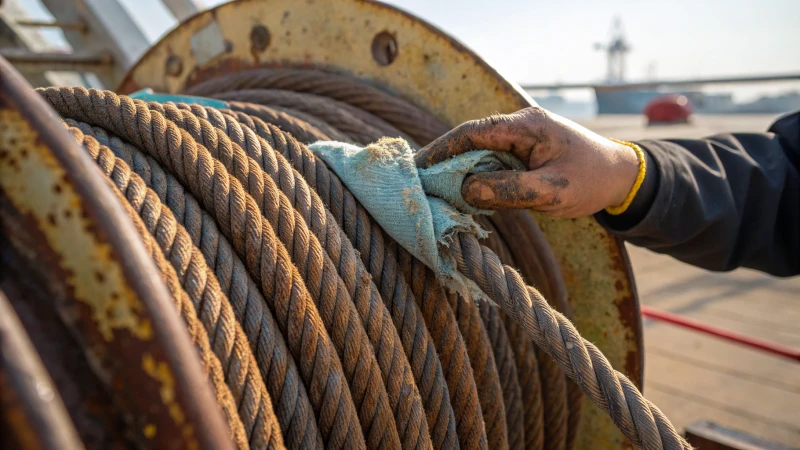
Understanding the Basics of Steel Wire Ropes
Steel wire ropes might look like just a bundle of metal wires twisted together, but each strand is a hero in its own right. I remember when I first saw one in action during a construction site visit—it was incredible watching it lift massive beams effortlessly. These ropes are built for strength and flexibility6, vital for heavy-duty tasks. But just like any hero, they need care and protection against harsh elements that can cause damage.
Common Problems Without Regular Maintenance
Corrosion: Imagine a knight's armor getting rusty; that’s what happens to steel wire ropes in moist environments if ignored. I’ve seen ropes that looked fine on the outside but were rusting away inside—an accident waiting to happen.
Wear and Tear: Over time, even the toughest ropes can start to fray. It's like the shoes you wear every day; they eventually show signs of wear. Routine checks can catch these early signs before they become a problem.
Fatigue: Just like us after a long day, ropes get tired too. Repeated stress leads to metal fatigue. Proper tension adjustment and timely replacements are part of keeping them in peak condition.
Key Maintenance Practices
| Maintenance Task | Description |
|---|---|
| Inspection | Regular visual checks for corrosion, kinks, or broken wires. Use a magnifying glass for detailed inspection. |
| Lubrication | Apply appropriate lubricants to reduce friction and protect against corrosion. Check compatibility with rope materials. |
| Replacement | Replace worn or damaged sections promptly to avoid catastrophic failure. Document each replacement for future reference. |
Benefits of Regular Maintenance
- Enhanced Safety: Well-maintained ropes mean fewer accidents—a huge relief when you’re responsible for safety on-site.
- Increased Longevity: Just like regular exercise keeps us healthy, maintenance prolongs rope life, saving money in the long run.
- Operational Efficiency: Downtime is a major headache. Regular upkeep ensures everything runs smoothly.
Industry Guidelines and Standards
By sticking to industry standards like those from the American Society for Testing and Materials7, you’re not just protecting equipment but also the people working nearby. Compliance means peace of mind, knowing that safety boxes are checked.
Steel wire ropes are prone to corrosion in dry environments.False
Corrosion mainly occurs in marine or high-moisture areas, not dry environments.
Regular lubrication reduces friction in steel wire ropes.True
Lubrication minimizes friction, protecting the ropes and prolonging their life.
Why is pre-stretching important for wire rope longevity?
Imagine your wire ropes performing flawlessly, even under the toughest conditions. That's the power of pre-stretching.
Pre-stretching wire ropes reduces stretch and deformation by aligning internal strands, distributing loads evenly. This technique enhances durability and reliability, especially in high-stress applications.
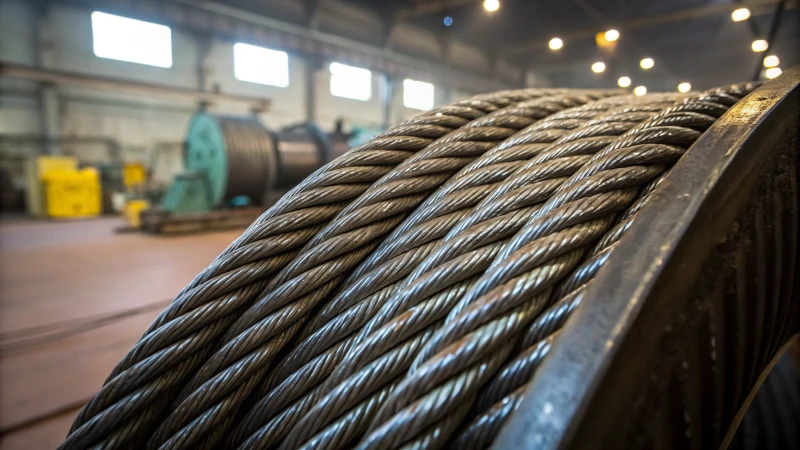
Understanding Pre-Stretching Techniques
I remember the first time I came across the concept of pre-stretching wire ropes. It was during a project where reliability was non-negotiable. Pre-stretching involves elongating the ropes under controlled tension, a bit like gently coaxing them into their optimal shape. This method aligns8 the strands and wires within the rope, ensuring each segment bears an even load. It’s like tuning a musical instrument; everything just works better.
Benefits of Pre-Stretching:
| Benefit | Description |
|---|---|
| Enhanced Load Distribution | Pre-stretched ropes distribute weight more evenly across strands. |
| Reduced Elongation | Minimizes rope elongation over time, maintaining its initial length. |
| Increased Strength | Aligns fibers to enhance tensile strength. |
Application in Industries
Industries like construction and mining benefit immensely from pre-stretched wire ropes. Picture a bustling construction9 site with cranes lifting heavy materials effortlessly — pre-stretching makes this possible by reducing wear on individual wires, thus extending the rope's service life.
In mining operations, where ropes face harsh conditions, pre-stretched ropes maintain their structural integrity longer than their non-stretched counterparts. This durability is not just a technical advantage; it’s crucial for safety and efficiency.
Technical Insights
Pre-stretching also impacts the mechanical properties of wire ropes. It boosts tensile strength10, making them more resistant to breakage under heavy loads. Engineers often prefer pre-stretched ropes for critical applications where failure is not an option.
Moreover, pre-stretching can improve the rope's flexibility by eliminating slack and reducing the risk of kinks and bends during operation. This flexibility is especially beneficial in dynamic environments where ropes undergo constant movement and stress.
To conclude, while pre-stretching is not a universal solution for all wire rope issues, it offers significant benefits that can enhance the longevity and performance of wire ropes used in demanding industries.
Pre-stretching reduces wire rope elongation over time.True
Pre-stretching aligns strands, maintaining initial length under tension.
Pre-stretched ropes are less flexible than non-stretched ones.False
Pre-stretching improves flexibility by reducing slack and kinks.
Conclusion
To ensure steel wire rope durability and performance, select appropriate materials, utilize advanced coatings for corrosion resistance, and maintain a regular inspection and maintenance routine.
-
Learn about the benefits of using stainless steel for its corrosion resistance. ↩
-
Find out how pre-stretching techniques improve performance in heavy-duty applications. ↩
-
Learn why coated steel wire ropes are essential in mining operations for enhanced durability and safety. ↩
-
Understand how coatings and pre-stretching improve load-bearing capabilities in steel wire ropes. ↩
-
Explore the newest coating innovations that enhance steel wire rope applications in harsh environments. ↩
-
Exploring this link can provide deeper insights into how different constructions affect rope performance. ↩
-
This link offers essential information on safety standards and compliance for maintaining steel wire ropes. ↩
-
Discover how pre-stretching aligns internal strands for even load distribution. ↩
-
Learn why cranes rely on pre-stretched ropes for precise heavy lifting. ↩
-
Understand how pre-stretching enhances tensile strength, reducing breakage risk. ↩

